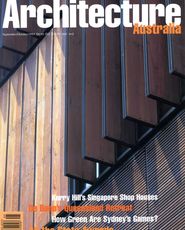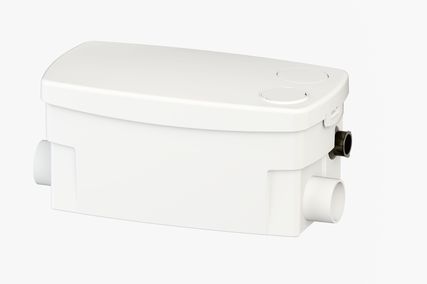| ||||
| The Fibro Frontier: A Different History of Australian Architecture By Charles Pickett, Transworld/ Powerhouse Publishing, $29.95.
James Broadbent, a Don of Australia’s heritage mafia, here offers his life’s research—early Sydney houses and their owners—on 400 eggshell pages immaculately presented between hard covers. Much of his doctorate material must have been left out of this volume, but what remains is a work of valuable width and depth: plainly worded, extensively footnoted and accompanied by many pictures of a clarity and quality that’s rare for books sourced from 19th century archives. Broadbent begins his narrative with the first permanent house built after settlement at Port Jackson: the “meagre” two-storey brick dwelling of Governor Arthur Phillip, commander of the First Fleet, to a Georgian design common for English farmhouses. Further chapters explain the development of verandahs on some “sophisticated” houses during the first 20 years of English occupation; explore the impacts of the Macquaries on domestic architecture in the settlement (pre and post-Francis Greenway); and discuss the activities of notable building planners of the early 19th century—including Henry Kitchen, John Verge and owner-designers such as John Macarthur. The final chapter focuses on the collapse of the colony’s extravagant economy (sustained by the free labour of convicts) and the depression of the 1840s, after transportation was abolished and land values fell in tandem with overseas wool prices. Although this book will mainly interest Sydney heritage fans, it is a classic record of the period. |  A Spirit of Progress: Art Deco Architecture in Australia A Spirit of Progress: Art Deco Architecture in AustraliaBy Patrick Van Daele and Roy Lumby, Craftsman House, $95. Photographer Patrick van Daele introduces this book with a contestable quote from photographer Diane Arbus. “It is that which you have never seen before you most easily recognise,” he has her claim as a strut to an argument that “Art Deco architecture was not a frivolous fantasy for eccentrics but a mainstream style used by prominent architects”. While the Arbus point must be countered with Robert Hughes’ regularly proven reference to the shock of the new, van Daele’s conclusion is correct; to a point. Unfortunately, Deco architecture, like Gothic, Baroque and Nouveau, basically suffers a cred problem arising from its associations with embellishment and frivolity and, in logic from there, fatuity. In the chapters, author Roy Lumby does much to explain why the style arose internationally (triggered by American industrial designers fascinated with streamlining motor vehicles and fuelled by Hollywood film sets) and how it was adapted to Australian tastes. Gorgeous photographs—some hand-coloured to highlight genuine bits from dross which came later—are the meat of the book. This is a real treat for followers of those15 years of exuberant creation.
Australia’s Guide to Good Residential Designedited by Dimity Reed of RMIT for the National Office of Local Government, free. Domestic House Construction: Basics and Footingsby George Cross, RMIT Publishing, $45. Contract Administration for the Building Team by The Aqua Group, Blackwell Science Asia, $42. Timber for Buildingby Peter A. Campbell, RMIT Publishing, $35. |

 Vilified by Patrick White, sneered at by Barry Humphries, inhabited by the Whitlams and exemplified by Robin Boyd, the asbestos cement houses of Australia’s mid-century suburbs are here revisited by the Powerhouse Museum’s curator of social history, who himself grew up in a fibro home. Drawing from old copies of Australian Home Beautiful (“that seminal periodical,” notes Barry Humphries in the foreword), Architecture Australia, builders’ brochures, Wunderlich Durabestos catalogues and family photos, Pickett warmly explores many peoples’ memories of a building material which was both life-sustaining and murderous. His text details how such houses were built—often by amateurs with a helping hand from the neighbours—and externally designed in styles ranging from Dandenongs Gumnut Tudor to Roy Grounds’ Ship. Although the book is mainly devoted to houses, it also includes photos of some large recent commercial buildings—including Ric Fiala’s Ansett terminal in Sydney and Frank Alvarez’s Shoppingtown at Doncaster—clad in (non-asbestos) fibre cement. These hint at a non-domestic future for fibro.
Vilified by Patrick White, sneered at by Barry Humphries, inhabited by the Whitlams and exemplified by Robin Boyd, the asbestos cement houses of Australia’s mid-century suburbs are here revisited by the Powerhouse Museum’s curator of social history, who himself grew up in a fibro home. Drawing from old copies of Australian Home Beautiful (“that seminal periodical,” notes Barry Humphries in the foreword), Architecture Australia, builders’ brochures, Wunderlich Durabestos catalogues and family photos, Pickett warmly explores many peoples’ memories of a building material which was both life-sustaining and murderous. His text details how such houses were built—often by amateurs with a helping hand from the neighbours—and externally designed in styles ranging from Dandenongs Gumnut Tudor to Roy Grounds’ Ship. Although the book is mainly devoted to houses, it also includes photos of some large recent commercial buildings—including Ric Fiala’s Ansett terminal in Sydney and Frank Alvarez’s Shoppingtown at Doncaster—clad in (non-asbestos) fibre cement. These hint at a non-domestic future for fibro. Conceived for the bicentenary of Lieutenant Shortland’s arrival (he was neither the first European nor a settler) in 1797, this palm-sized guide offers a photograph and notes (regrettably no plans) on 160 local structures. Notable projects include Thomas Morriset’s convict-excavated rock pool below Shepherd’s Hill, the 30-year suite of award-winning works at the university, and buildings by cross-century practitioners Thomas Mencken, James Henderson, Peter Bennett and Ernest Yeomans—as well as key architects still thriving.
Conceived for the bicentenary of Lieutenant Shortland’s arrival (he was neither the first European nor a settler) in 1797, this palm-sized guide offers a photograph and notes (regrettably no plans) on 160 local structures. Notable projects include Thomas Morriset’s convict-excavated rock pool below Shepherd’s Hill, the 30-year suite of award-winning works at the university, and buildings by cross-century practitioners Thomas Mencken, James Henderson, Peter Bennett and Ernest Yeomans—as well as key architects still thriving.













